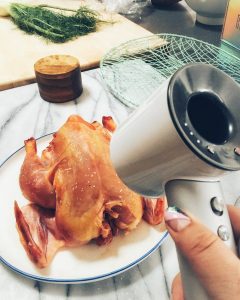Helen Rosner, a food writer for The New Yorker, uploaded a photo of herself using a $400 Dyson Supersonic Hair Dryer to blow dry a whole chicken.
 “Happy snow day, I am using an astonishingly expensive hair dryer to remove all moisture from a chicken to maximize skin crispiness when I roast it,” Rosner writes in the post, which has earned over 1,600 likes and 100 comments.
“Happy snow day, I am using an astonishingly expensive hair dryer to remove all moisture from a chicken to maximize skin crispiness when I roast it,” Rosner writes in the post, which has earned over 1,600 likes and 100 comments.
Rosner went on to share the recipe for her roasted chicken, but fans were most interested in the first stage of her process – the hair dryer.
“For crisp skin, whether you’re cooking a chicken or a duck or a fish, you want there to be as little water moisture as possible, which is sped up by a fan. And that’s all a hair-dryer really is — a hand-held fan that you can pretty easily bring into the kitchen,” she said to Allure, likening the process to Food Network star Alton Brown using a box fan to make beef jerky.

.jpg) brown and an instant-read thermometer inserted into the meaty part of the thigh reads 155 to 165 degrees.”
brown and an instant-read thermometer inserted into the meaty part of the thigh reads 155 to 165 degrees.”